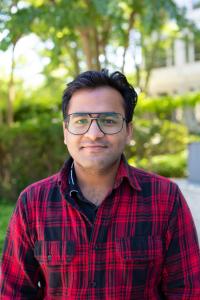You are here
Divyansh Chamria
Colgate University
NIST Research Intern
National Institute of Standards and Technology (NIST)
Final presentation
![]() Div Chamria - Final Presentation.pdf
Div Chamria - Final Presentation.pdf
Electronic devices, especially those utilizing semiconductor materials, have become ubiquitous in our lives, being used in almost every industry. Because of this, continued further research into new electronic materials is very important in order to improve these technologies. A significant part of this research is dedicated to measuring various electronic properties of these devices using spectroscopic and electrical techniques. This project focuses on the characterization of semiconductor devices using Photoemission Electron Microscopy (PEEM) and electrical measurements.
PEEM is an important method of imaging and spectroscopy for materials, due to its extreme surface sensitivity and high spatial resolution. Custom sample holders can offer us a variety of additional functionality for the PEEM, such as the application of an electrical potential to perform operando measurements. We have designed a sample holder to accept two additional electrical contacts that should be stable under high voltages of up to 20 kV. The design will be fabricated and implemented in the near future. This added functionality allows us to image the effects of a potential applied to samples, and serves as a base for other modifications to be made.
Electrical measurements allow us to measure the functionality of devices. These measurements are performed using probe stations and with voltage sources and electrometers to measure variables such as current and resistance. We built programs using PyMeasure to control a Yokogawa 7651 power source, and a Keithley 6514 electrometer simultaneously. This allowed for all the functionality offered by most commercial sourcemeters, with a higher degree of control over the other instruments. The program also supports a second constant voltage source for transistor measurements. Similar programs were also built and tested for an Agilent E4980A LCR meter, which measures capacitance over a range of frequencies or bias voltages. This allows for more specialized applications such as measuring how capacitance changes over a voltage sweep. The instruments were tested with various resistors, semiconductors, and capacitors, to ensure accuracy and reliability.
My name is Div Chamria (he/him) and I am a rising senior at Colgate University, double majoring in Physics and Chemistry. I am also the co-president of Colgate University’s SPS chapter. I am from Kolkata, India, and have spent most of my time in the US on the East coast. I am one of the NIST interns, and will be working on photoemission electron microscopy (PEEM) this summer. I am interested in interdisciplinary fields such as materials science, and am hoping that this position will give me the experience necessary to work in a research environment later on. I plan to apply to graduate school to pursue a PhD in Physics, and I want to continue doing research after I am out of school.
I spend most of my free time biking, playing board games with friends, baking breads, and playing guitar. I am very thankful to SPS and NIST for this opportunity, and look forward to spending the summer with the other interns!

